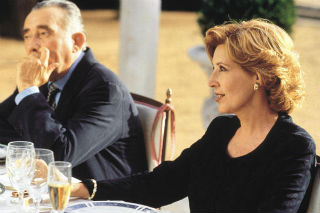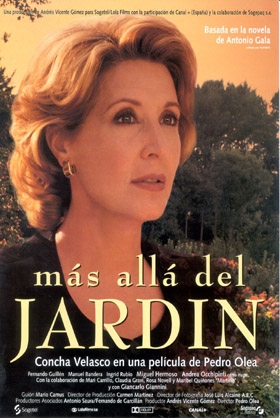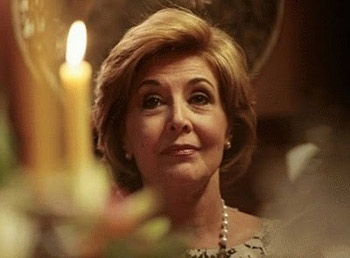
It soon became obvious that there
were only two countries with minimum infrastructure requirements to
carry out a complicated shoot and where it would look like the
action was taking place in Rwanda: the Ivory Coast and Senegal. The
former was discarded because the rainy season was starting at the
time we were ready to start the job. Senegal seemed like the
appropriate country to build the Rwandan scenes that Gala described
in his novel. We had photos, books and videos that had been given
to us by some missionaries and we thought that we were on the right
track.
We got in touch with the Spanish
Embassy in Dakar and the first thing they told us was that it was
not advisable for us to shoot in the southern Casamance region as
it was the nucleus of an independence movement and the previous
year the guerrillas had killed several French tourists. And yet,
according to the data at our disposal, it was precisely there where
we could find the right scenery to simulate the refugee camp in our
story.
A few of us set out to locate
suitable exterior shooting sites and to ascertain the real dangers
we might encounter if we decided to work there.
The Spaniards we met in Senegal and
who later helped us with the filming, assured us that there was no
problem at all for a film crew in Casamance. On the contrary, they
said that we would be very well received since we would employ many
local people. Besides, the story about the French tourists who had
disappeared was not very clear; in Casamance the local version held
that it was made up to discredit the separatist movement.
One only needs to glance at the map
to understand a couple of facts. Geographically, Casamance is
almost entirely separated from the rest of Senegal by Gambia.
Following the partitioning of Africa by European Colonialists - the
main cause of current conflicts, not to forget that in the
aftermath of colonialism Europeans continued selling weapons to the
Africans to kill one another - Gambia became a region of British
influence in their eagerness to find an outlet to the sea and
Casamance became part of French Senegal. This south-eastern
territory is populated by people from the Diola ethnic group (7% of
the Senegalese population), which practices a curious mix of the
Christian faith and animism. They were conquered by the French at
the end of the 19th century despite a strong resistance from
religious leaders like Fodé Kaba Doumbouya, the historic hero of
today's independence movement. Since then, and after the
independence of Senegal in the 1960s, the territory is governed
from Dakar as a Senegalese province. About 40% of Senegal's
population is part of the Wolof ethnic group and most are Muslims.
Now and again, secessionist revolts break out.
During our stay there, a guerrilla
led by a religious leader was hiding in the deep jungles that
stretch towards Guinea Bissau. However, they were in negotiations
with the central Government of Dakar to increase their local
autonomy and at the time the situation was reasonably peaceful.
With that information, we headed
for Casamance aboard the small plane that covers the route between
Dakar and Ziguinchor, the capital of the region, and which flies
over Gambia. We were very warmly welcomed. We decided that the
airport of Ziguinchor could be the starting point of the film;
Palmira Gadea's arrival in Kigali. Fascinated by what we saw, we
continued covering the whole region. It was becoming clear to us
that we should film there, although we still had to find the most
important thing of all: the refugee camp that appears at the end of
the movie. Every day we'd clear several military checkpoints and
carried on with our job.

During this first location search,
we only had one major scare. It happened one day at dusk when the
accursed Anopheles malaria-transmitting mosquito becomes active. On
our way back to the hotel, we stopped to watch an animist ceremony.
Our Senegalese driver tried to deter us on the grounds that it
wasn't something touristic but rather, a very serious ritual: the
ritual of the "crazy lion". His explanation just made us more
curious, so we got out of the jeep without the driver - nothing in
the world could persuade him to join us - and walked to a field
near a settlement where, by the light of several bonfires, the
ritual was taking place. Amid a circle of people, the "Lion
Priests" belonging to a caste that exclusively devotes itself to
these rituals, jumped up and down in a violent ballet, their faces
painted, dressed like wild animals, with blood-shot eyes- screaming
like epileptics and terrifying all those present. Meanwhile,
another "priest" -a transvestite-like character- was directing the
show. We were advised to buy ourselves a little piece of paper with
some signs written on the back, which an acolyte was ripping out of
a notebook, as a means of protecting ourselves from a potential
clawing swipe from the odd performer who might not like us. And so
we did.
Suddenly, the "crazy lions" exited
the circle. Some of them took off towards the settlement. Others
stayed there, in a trance, hardly moving. The first lot however,
pounced on whoever didn't show to them the "ticket-óbolo" and
dragged the victim towards the circle, until he paid up or the
"lion" got tired. There were some children there who, while the
priests "played" at eating them, got so frightened that they peed
their pants until their mother turned up and, after paying their
dues, rescued her poor offspring. We were standing there motionless
with our little paper well in sight just in case, and glancing at
each other out of the corner of our eyes. Mind you, they soon
enough spotted us and approached. They surrounded us and roared a
few inches away from our faces. Pity we couldn't take a snapshot or
two of that moment although it most certainly wasn't the right time
to be a foreigner or tourist. There we were, scared as hell and
pathetically showing them our little papers until they left us
alone. We retreated as discreetly as we could towards the jeep,
where our driver was waiting for us, looking worried. As he turned
on the engine, it was nightfall, but the "crazy lions" continued
terrifying the neighborhood.
At length, we arrived at Cap
Skining. Relatively near there - I say this for the benefit of any
atypical tourist who might be eager to dive into this amazing world
- there are cabins where one can practice an integration type of
tourism. Anyway, soon enough Diembering came into view, with its
sacred forest of millenary trees. There was our perfect location
for the refugee camp. At last we had found our African exterior
location for the film.
Upon our return to Madrid, we
continued working on the film. While we toured Seville - where the
only difficult thing was to find Palmira's garden - the guys from
the production department spoke once more with the Spanish Embassy.
Again, the ambassador didn't approve and said the Embassy could not
guarantee our safety if we insisted on filming in Casamance. But
the decision had already been made. The entire crew had to sign a
document stating that we would be responsible for anything that
might happen to us. That done, and having been vaccinated against
many different illnesses and equipped ourselves
withdifficult-to-digestmalaria pills, we returned to start shooting
the film.
It took time before we met the
Ambassador. During the time we were engaged in locating sites for
shooting exteriors, he apparently had to accompany some Spanish
friends who wanted to tour around Saint Louis, a beautiful colonial
city in northern Senegal. And when we began filming, he only
appeared once on the island of Gorée, near Dakar, where we were
working on the initial scenes of the film; the ones in which the
mission where Palmira works as a nurse appears. The Ambassador had
lunch with us and had many photos of himself taken with Concha
Velasco for the magazines and news agencies that were following the
shooting. When we went back to Spain, once in Seville, we cracked
up laughing when we read that we had worked with the full support
of the Spanish Embassy in general and of the Ambassador in
particular.
The most thrilling filming was done
in Casamance. The equipment - a double set of cameras, the power
pack, dollies, crane, etc., had arrived by ship while most of us
travelled in small groups, by regular airline plane or on small
planes. Others travelled on trucks, crossing over the river
Gambia.
Our starting point was Ziguinchor,
with the sequences of Palmira arriving in Rwanda. We needed
soldiers, to create the impression that the airport had been taken
over by the military, and we were able to obtain the collaboration
of the Senegalese army. They say that military logic is to logic
what military logic is to music and the saying was no exception
over there: the soldiers wanted to appear in the film dressed
impeccably in their best military clothes like when on parade. We
had to tell them repeatedly that we were doing a film about the war
in Rwanda, not a report about the virtues of the Senegalese army.
We had to resort to the highest circles at the governmental level
to obtain permits for them to wear clothes from our own wardrobe
during the shooting. And the truth is that they performed very
well.

But later on, regardless of whether
we needed them anymore or not, they accompanied us throughout the
rest of the shooting for security reasons. In the end, we arrived
in Diomboring, where we worked with over one thousand extras from
the Independence region.
There were cases of alleged
guerrilla fighters who, upon leaving jail, would immediately join
the others as an extra. A female colleague from the crew told us
she had gotten to know one of the extras and ended up going with
him to his hut. The decoration was very simple: a worn-out
mattress, a table, a poster of Wojtyla on the wall and a submachine
gun in a corner. She asked him if the weapon was from the filming,
and he replied convincingly: "No, it's mine."
We were worried that in the final
scenes - with Senegalese soldiers playing the role of Tutsis and
"firing" at others who played Hutus - an incident or confrontation
might occur and that we might in the end have to acknowledge that
at least partly, the Spanish Embassy was right in its warnings. But
as it turned out, there was not the slightest trouble. We explained
clearly to everyone what we wanted to convey in the film to ensure
that everything went well.
And thus we carried on working
until the end, getting on well with the Senegalese team and doing
what I think was a good job: sometime we commented amongst us what
filming "Out of Africa" must have been like, with their impressive
display of super-air conditioned caravans. We ourselves only had
one caravan and the A/C never worked. But we only envied them to a
certain extent because it must be admitted that our experience was
extraordinary in many different ways.
Now, every time I have to see the
film, I can't help feeling moved, not because of the film in
itself, but because of all that lies behind every shot we filmed in
Senegal. It was certainly worthwhile.
PEDRO OLEA.